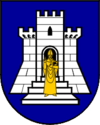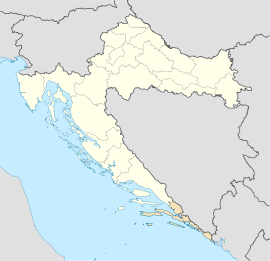Korčula (town)
| Korčula | ||
|
||
|
|
||
| Basic data | ||
|---|---|---|
| State : |
|
|
| County : |
|
|
| Island : | Korčula | |
| Height : | 0 m. i. J. | |
| Residents : | 5,663 (2011) | |
| Telephone code : | (+385) 020 | |
| Postal code : | 20 260 | |
| License plate : | YOU | |
| Boat registration : | KO | |
| Structure and administration (status: 2013, cf. ) |
||
| Community type : | city | |
| Mayor : | Vinko Kapelina ( HDZ ) | |
| Postal address : | Trg Antuna i Stjepana Radića 1 20 260 Korčula |
|
| Website : | ||
Korčula [ ˈkɔːrtʃula ] ( Italian Curzola , Latin Corcyra Nigra , Greek Korkyra Melaina ) is a Croatian port town on the island of Korčula .
history
This city was shaped by Greeks , Romans , Illyrians , Croats and Venetians . The oldest building remains in Korčula are fragments with willow ornaments from the 10th to 11th centuries. The Croatians who settled the city in the 9th century called it Krkar or Karkar . In 1001 Korčula came under the rule of Venice for the first time, then the Zahumlje ruled over the entire island and then Croatian-Hungarian kings. In 1256, Venice recaptured Korčula.
The document for the foundation of the city dates from the 13th century. In 1298 there was fighting between Venetians and Genoese in the waters off the city. The Venetians with Marco Polo gained complete sovereignty over Korčula in this naval battle. Marco Polo became one of the most important residents, whose traces are still clearly visible in the 21st century.
In 1301 a diocese was founded in Korčula and the parish of All Saints was established. Other parishes such as St. Rocco (end of the 16th century) and Our Lady of the Belt - St. Mihovil (beginning of the 17th century) developed and built places of worship .
In the following period ( Middle Ages ) the city was massively expanded. Inside, all traffic routes ran in a herringbone pattern , starting from the center around the San Marcus Cathedral. The clearly structured complex is a specialty in Europe. Residential buildings, churches and communal facilities were built on precisely defined properties. All buildings are often provided with decorative windows, doors, architecturally successful corner solutions and with decorative elements such as the coats of arms of the owners and are mainly designed in the late Gothic and Renaissance styles . Stones from the island of Korčula were used as the main building material.
Until the end of the Republic of Venice, the Doges retained sovereignty over Korčula. Then Austrians, French, Russians and British conquered the city-state one after the other. From the Congress of Vienna from 1815 to 1918 Korčula belonged to the Austro-Hungarian monarchy . After the local elections in 1871, Rafo Arneri, a member of the Dalmatian parliament, took power in the city for the first time.
From autumn 1918 to 1941 Korčula was part of the SHS state, from 1929 of the Kingdom of Yugoslavia .
During the Second World War Korčula was under Italian rule from 1941 to 1943 and under German occupation from late 1943 to September 1944. After the war ended, Korčula belonged to the SFR Yugoslavia . Only when Yugoslavia fell apart, Korčula became part of the newly founded Republic of Croatia.
In the city there are mainly buildings by the architects Karlić, Pomenić, Hranić-Dragošević and Andrijić. The long influence of the Venetians can be clearly seen in many places, the lion of St. Mark is often represented.
Although it was taken over by new rulers several times, the city was never destroyed, so that many historical buildings have been preserved and are under monument protection.
location
The old town of Korčula is located on a small peninsula on the island of Korčula. The western city limits run along the harbor between two visible defense towers.
Population development
Korčula had over 5,000 inhabitants in the 2010s and is the center of the island's cultural and tourist life.
Attractions
In St. Mark's Cathedral you can admire the world-famous altarpiece by Jacopo Tintoretto (representation of St. Mark with St. Bartholomew and Jerome).
The alleged birthplace of Marco Polo can be visited in the city . However, despite Marco Polo's own statements to the contrary ( Venice ) in his book Il Milione, there are traditionally contradicting opinions in Croatia about the place of his birth. However, there is no valid evidence of the supposed place of birth Korčula, then Venetian .
Traditions
The Moriska dance ( Moreška ) has been performed in Korčula since the 15th century . This tradition originally comes from Spain and was widespread in the Mediterranean. The Moriskentanz symbolizes a fight that is carried out by the armies of a Christian and a Moorish king over a stolen woman. After a sword fight represented by seven dance figures and a dramatic dialogue, the western king wins and frees his beloved. The fight is accompanied by marching music from a marching band . The Moreška is traditionally performed on July 29th, the day of the martyr Theodore .
sons and daughters of the town
- Dalibor Vačkář (1906–1984), composer
Others
The novel Queen of the Seas , the most successful work of Marianne Langewiesche , playing in the city and was from a stay of the author there inspired .
photos
Altar painting by Jacopo Tintoretto in St. Mark's Cathedral
Marco Polo's alleged birthplace
Individual evidence
- ↑ gutenberg.org , bibliotecaitaliana.it ( Memento of November 22, 2007 in the Internet Archive ), resident.it ( Memento of September 28, 2007 in the Internet Archive )













